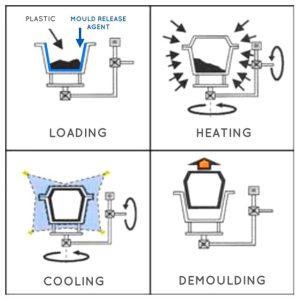Rotomolding is a method used to produce hollow plastic parts. Usually associated with the production of tanks, but this technology is beginning to be applied to make different plastic parts for the medical sector, agriculture, gardening, automotive components, toys, sports equipment, etc.
In recent decades there have been a number of very important technical advances that have led to an improvement of technology with new machines, molds and materials at very competitive prices.
The operation principle of rotomolding is simple and allows the manufacturer to control very precisely the dimensions and properties of their parts. The molds used with this technique are relatively inexpensive and allow the production of hollow pieces without welds, controlling the thickness of the wall without having to modify the mold. The process can be very automated and there is no waste of raw material.
With a suitable mold design and the use of a good mold release agent, it is possible to rotomold complex parts that would be difficult to produce by other methods such as blowing or thermoforming.
The process consists of introducing a certain quantity of plastic resin powder, usually granulated, into a hollow shell-shaped mold. The mold is heated to temperatures in excess of 200 °C while rotating on two axes at a rotational speed of 5 to 25 r.p.m. so that the plastic melts and adheres forming a layer on the inside of the mold. In the cooling phase, the mold continues to rotate so that the plastic solidifies homogeneously with the desired shape. Once the plastic has the desired final shape and properties, the rotation stops and the part is removed.
The raw material used in this method can be applied in both liquid form (flexible PVC or PVC Plastisol) and powder (HDPE, LDPE, LLDPE, crosslinked Polyethylene, EVA, Nylon, Polycarbonate).
Figure 1. Rotomolding process
Concentrol developed in its laboratories the solvent-based release agent CONCENTROL LP PD-106 and the water-based release agent CONCENTROL PA-2, both highly efficient for the rotomolding method.
These products are applied to the mold at the beginning of the process providing a protective lubricating barrier for the metal surface of the mold and ensuring mold contact with the plastic during the heating and cooling cycles until the part has the required structural cohesion. The same mold release allows quick and easy removal of the part without any abrasion on the surface.
The release agent is not transferred to the surface of the final product so it does not interfere with subsequent processes. Depending on the type of plastic, a curing of the film is not needed before proceeding to rotomold it, and the satin finish that it gives to the product is suitable for most parts.
The product’s excellent efficiency allows several cycles with a single application.
To receive further information about Concentrol products and the benefits we can offer your business, contact us and our experts will assist you with solutions tailored to your needs.



